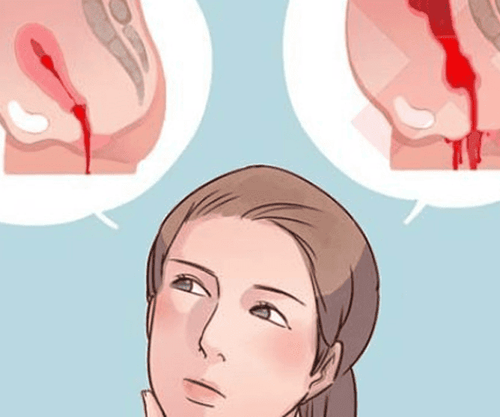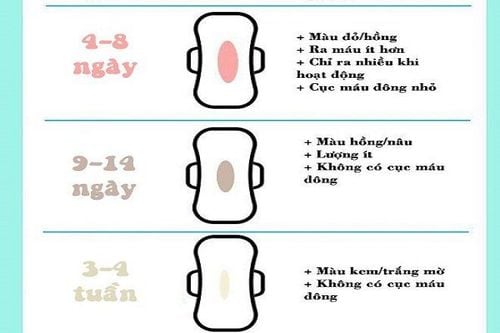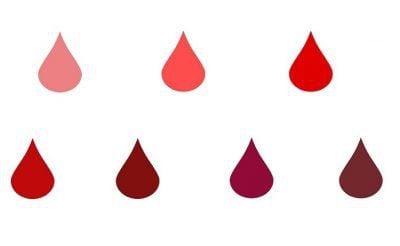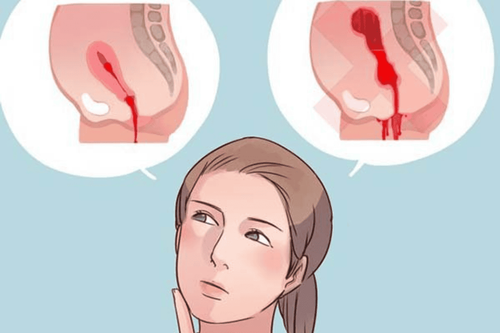This is an automatically translated article.
The article was professionally consulted by Doctor Le Van Linh - Department of Obstetrics and Gynecology - Vinmec Phu Quoc International General Hospital.Postpartum discharge is a normal phenomenon when a woman's body after giving birth needs to get rid of the fluid that flows into the uterus to clean the uterus and then out through the vagina. Usually, postpartum discharge will go away on its own after a few weeks.
1. What is postpartum fluid?
Loose fluid is a vaginal discharge that is excreted after birth, consisting of blood and the lining tissues of the uterus. The moment the placenta begins to detach from the uterus, the blood vessels between the uterus and the placenta open up. Some blood will lead into the uterus to clean the uterus and then through the vagina out. When the entire placenta is out, the uterus continues to contract to close all blood vessels, reducing blood loss in the body.The first day postpartum discharge is blood red, bright red. But after 2 to 4 days, the blood vessels of the uterus heal, the bleeding is less, and the discharge gradually turns pink. After 10 days, the discharge is still yellow or white because the basic components in the discharge are white blood cells and the lining tissue of the uterus.
In the early days, the amount of discharge is large, even bright red blood clots can be seen. Gradually, the product turns pink, then brown, then yellow, and finally white.
The amount of fluid excreted from the body is the most in the first day after birth. But this is not the most worrisome problem, to continue blood circulation and blood production in the body, you should limit exercise and increase rest.

Sản dịch sau sinh thường ra nhiều nhất vào ngày đầu sau sinh và hết dần theo cơ địa từng người
2. How many days will it take to give birth after giving birth?
Whether giving birth by cesarean or vaginal birth, immediately after birth, fluid will appear. For each person, the time it takes to get out will be different and the ending will be different. So how long after cesarean delivery will it go away? Or how many days after giving birth will it go away? In fact, how long the discharge lasts is partly due to the mother's body and partly due to the care of the mother's body after birth. Usually this phenomenon will last about 20 days to 1 month, the longest is only 2 months for any method of birth.
The discharge is blood red, bright red, a sign that the blood vessels have not healed. After 2 to 4 weeks, the amount of discharge will be less. If you do not see a reduction in the amount of fluid, it means that you are working a bit too much and working too soon, so limit exercise and increase rest.
However, for mothers who have difficulty walking gently, these movements will create many useful conditions for the uterus to be stimulated to contract to push the fluid out, then return to its original size shape. . Mothers should go to a fertility clinic for re-examination if the discharge lasts more than 6 weeks to eliminate the causes of postpartum. For example, when the uterus does not contract well, the mother bleeds and loses a lot of blood; There are also mothers with stagnant fluid, unable to get out on their own, so intervention methods to avoid infection.

Thời gian kết thúc sản dịch tùy thuộc vào cơ địa từng người
3. Levels of postpartum fluid signaling
Every 2 hours, maybe a little more tampons are full, which means a lot of discharge. The tampon is full every 3 hours, which means the amount of discharge is moderate. When a tampon takes about 3 hours or more to fill, it means you are having a little discharge. Just small drops of blood or spots of blood mean your discharge is low. In addition, you should see an obstetrician-gynecologist as soon as you have the following warning symptoms of infection:
The discharge has a fishy, unpleasant odor. Body fever causes or chills The discharge is still bright red, not as relieved as the first day. Bleeding more, tampons fill faster every hour. Even after applying the resting mode, the bleeding still lasts more than 4 days The blood clots appear in small clots The body is weak, dizzy, lethargic Irregular heartbeat, may also beat faster normal.

Các mẹ nên trực tiếp đến gặp bác sĩ khi thời gian và màu sắc sản dịch bất thường
4. How to take care of and clean a woman's body after giving birth in the process of giving birth
Enhance rest: Postpartum women need to pay attention to body recovery care, avoid postpartum problems such as infections, bleeding, uterine prolapse ... Need a proper rest regime, Avoid overexertion.
Gentle exercise: After giving birth, mothers should only lie down and rest for the first 8 hours, then move around, gently exercise to help contract the uterus, accelerate the discharge, and shorten the process. postpartum.
Avoid tampons early: To reduce the trouble of discharge, use large size tampons for new mothers. Limit the use of tampons to avoid the risk of infection during the first 1 and a half months, especially for mothers who give birth vaginally. Because at this time, the condition of the uterus is in the recovery stage, prone to infection.
Keep hygiene absolutely clean: You need to change the tampon every hour, maybe every two hours in the first day, gradually stretch it out every 3 to 4 hours. Always wash your hands before and after changing tampons. Besides, try to take a quick bath with warm water once a day to keep the body clean and comfortable.
Wear loose-fitting clothes, old clothes can be used: Pants that are too tight will make it difficult to excrete the secretions, moreover, for mothers who have a lot of discharge, unfortunately, if the clothes are dirty, old clothes will help. Mom easily throws it away when it can't be washed.
Prolapse is completely normal in women after giving birth (including cesarean section and vaginal delivery), usually within 20 days to 1 month, the discharge will disappear. However, if you experience an abnormal situation from the discharge, you should return to the medical center to check and ensure the safety of mother and baby after birth.
Doctor Le Van Linh has 16 years of experience in the field of obstetrics and gynecology. With professional strengths such as treatment of obstetrics and gynecological diseases, gynecological cancer screening, breast cancer screening and pregnancy monitoring, Dr. Linh used to hold the position of Head of Obstetrics and Gynecology Department at the hospital. Hoan My Cuu Long (Can Tho). Currently, Dr. Linh is working at the Department of Obstetrics and Gynecology - Vinmec Phu Quoc International General Hospital.
Please dial HOTLINE for more information or register for an appointment HERE. Download MyVinmec app to make appointments faster and to manage your bookings easily.













